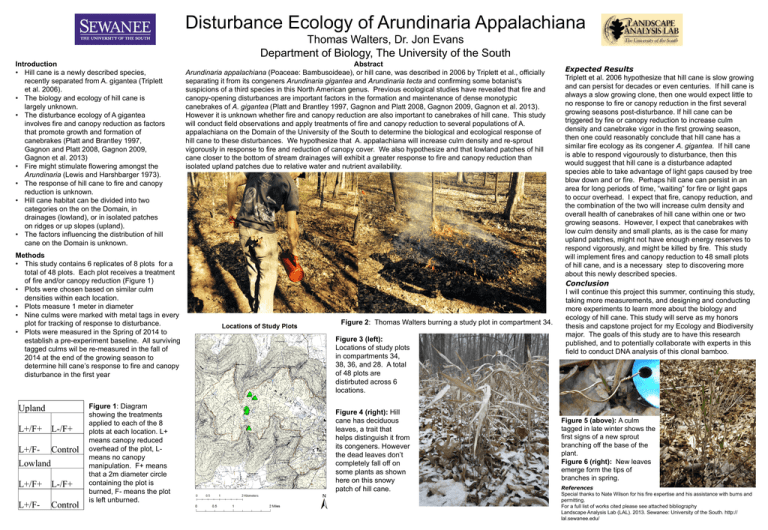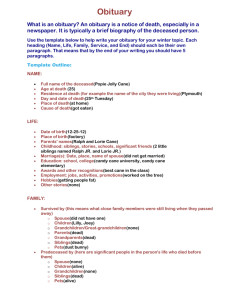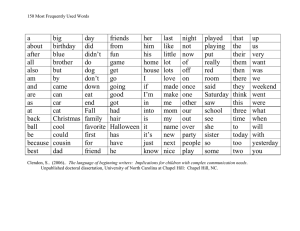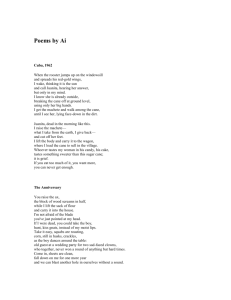Disturbance Ecology of Arundinaria Appalachiana Thomas Walters, Dr. Jon Evans
advertisement

Disturbance Ecology of Arundinaria Appalachiana Thomas Walters, Dr. Jon Evans Department of Biology, The University of the South Introduction • Hill cane is a newly described species, recently separated from A. gigantea (Triplett et al. 2006). • The biology and ecology of hill cane is largely unknown. • The disturbance ecology of A gigantea involves fire and canopy reduction as factors that promote growth and formation of canebrakes (Platt and Brantley 1997, Gagnon and Platt 2008, Gagnon 2009, Gagnon et al. 2013) • Fire might stimulate flowering amongst the Arundinaria (Lewis and Harshbarger 1973). • The response of hill cane to fire and canopy reduction is unknown. • Hill cane habitat can be divided into two categories on the on the Domain, in drainages (lowland), or in isolated patches on ridges or up slopes (upland). • The factors influencing the distribution of hill cane on the Domain is unknown. Methods • This study contains 6 replicates of 8 plots for a total of 48 plots. Each plot receives a treatment of fire and/or canopy reduction (Figure 1) • Plots were chosen based on similar culm densities within each location. • Plots measure 1 meter in diameter • Nine culms were marked with metal tags in every plot for tracking of response to disturbance. • Plots were measured in the Spring of 2014 to establish a pre-experiment baseline. All surviving tagged culms wil be re-measured in the fall of 2014 at the end of the growing season to determine hill cane’s response to fire and canopy disturbance in the first year Upland L+/F+ L-/F+ L+/F- Control Lowland L+/F+ L-/F+ L+/F- Control Figure 1: Diagram showing the treatments applied to each of the 8 plots at each location. L+ means canopy reduced overhead of the plot, Lmeans no canopy manipulation. F+ means that a 2m diameter circle containing the plot is burned, F- means the plot is left unburned. Abstract Arundinaria appalachiana (Poaceae: Bambusoideae), or hill cane, was described in 2006 by Triplett et al., officially separating it from its congeners Arundinaria gigantea and Arundinaria tecta and confirming some botanist's suspicions of a third species in this North American genus. Previous ecological studies have revealed that fire and canopy-opening disturbances are important factors in the formation and maintenance of dense monotypic canebrakes of A. gigantea (Platt and Brantley 1997, Gagnon and Platt 2008, Gagnon 2009, Gagnon et al. 2013). However it is unknown whether fire and canopy reduction are also important to canebrakes of hill cane. This study will conduct field observations and apply treatments of fire and canopy reduction to several populations of A. appalachiana on the Domain of the University of the South to determine the biological and ecological response of hill cane to these disturbances. We hypothesize that A. appalachiana will increase culm density and re-sprout vigorously in response to fire and reduction of canopy cover. We also hypothesize and that lowland patches of hill cane closer to the bottom of stream drainages will exhibit a greater response to fire and canopy reduction than isolated upland patches due to relative water and nutrient availability. Figure 2: Thomas Walters burning a study plot in compartment 34. Figure 3 (left): Locations of study plots in compartments 34, 38, 36, and 28. A total of 48 plots are distirbuted across 6 locations. Figure 4 (right): Hill cane has deciduous leaves, a trait that helps distinguish it from its congeners. However the dead leaves don’t completely fall off on some plants as shown here on this snowy patch of hill cane. Expected Results Triplett et al. 2006 hypothesize that hill cane is slow growing and can persist for decades or even centuries. If hill cane is always a slow growing clone, then one would expect little to no response to fire or canopy reduction in the first several growing seasons post-disturbance. If hill cane can be triggered by fire or canopy reduction to increase culm density and canebrake vigor in the first growing season, then one could reasonably conclude that hill cane has a similar fire ecology as its congener A. gigantea. If hill cane is able to respond vigourously to disturbance, then this would suggest that hill cane is a disturbance adapted species able to take advantage of light gaps caused by tree blow down and or fire. Perhaps hill cane can persist in an area for long periods of time, “waiting” for fire or light gaps to occur overhead. I expect that fire, canopy reduction, and the combination of the two will increase culm density and overall health of canebrakes of hill cane within one or two growing seasons. However, I expect that canebrakes with low culm density and small plants, as is the case for many upland patches, might not have enough energy reserves to respond vigorously, and might be killed by fire. This study will implement fires and canopy reduction to 48 small plots of hill cane, and is a necessary step to discovering more about this newly described species. Conclusion I will continue this project this summer, continuing this study, taking more measurements, and designing and conducting more experiments to learn more about the biology and ecology of hill cane. This study will serve as my honors thesis and capstone project for my Ecology and Biodiversity major. The goals of this study are to have this research published, and to potentially collaborate with experts in this field to conduct DNA analysis of this clonal bamboo. Figure 5 (above): A culm tagged in late winter shows the first signs of a new sprout branching off the base of the plant. Figure 6 (right): New leaves emerge form the tips of branches in spring. References Special thanks to Nate Wilson for his fire expertise and his assistance with burns and permitting. For a full list of works cited please see attached bibliography Landscape Analysis Lab (LAL). 2013. Sewanee: University of the South. http:// lal.sewanee.edu/






